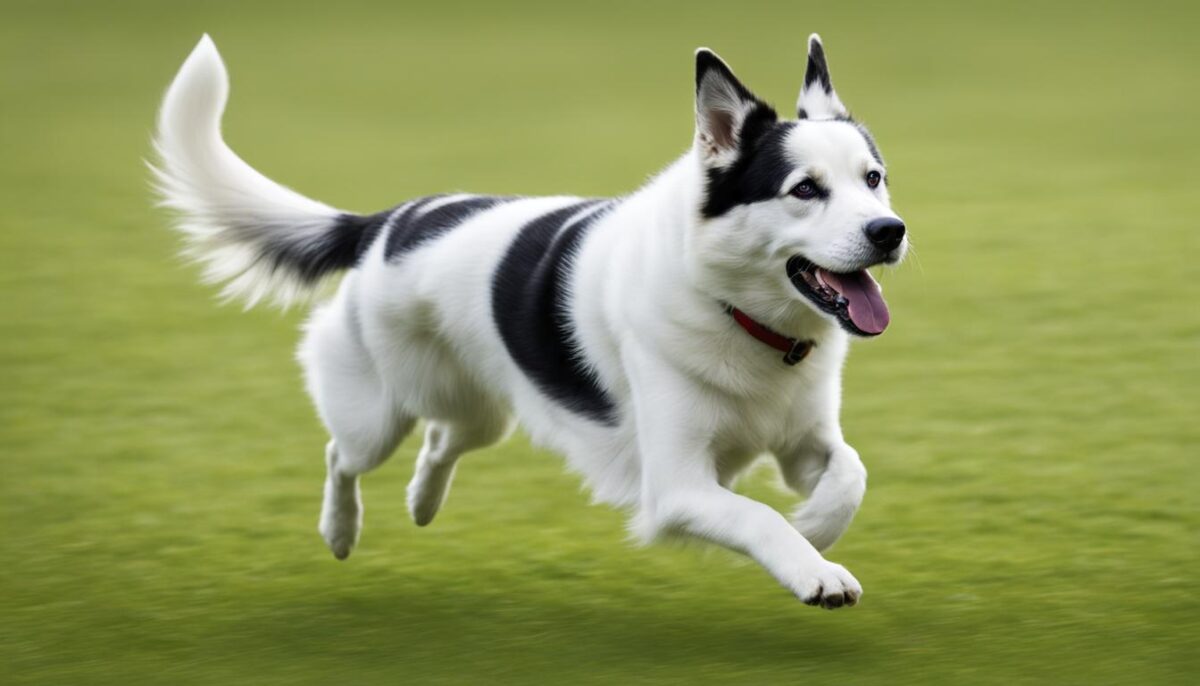Welcome! Have you ever wondered about your furry friend’s health and actions? You know, sometimes dogs act differently from others. They might not want to play with other pups or they keep doing the same thing over and over. This could make you wonder, can dogs get something like autism? Well, pet health is a big subject, and it’s good that you want to learn how to take care of your dog better.
Just like people, dogs can show different kinds of canine behavior that might confuse us. Autism in dogs isn’t exactly the same as in humans, but furry friends can act in ways that make us think they might feel things in a different way. This article is here to help you understand these behaviors better.
Key Takeaways
- Dogs can show unique behaviors that might look like autism but it’s usually called “canine dysfunctional behavior”.
- Understanding your dog’s actions can help you care for them in the best way.
- Better pet health starts with learning how your dog communicates and what their behavior means.
- If you notice your dog has habits that are hard to understand, it’s okay to ask a vet for help.
- Every pup is different, and that’s part of what makes them such great friends!
Exploring Canine Dysfunctional Behavior: A Look at Autism in Dogs
Just like people, dogs can show behaviors that seem a little different. Some dogs may not play as much, or they might do the same thing over and over again, like spinning in circles. These actions are part of something we call canine dysfunctional behavior, which can be similar to autism-like symptoms that some humans have.
Defining Canine Dysfunctional Behavior
Dogs with canine dysfunctional behavior aren’t deliberately being difficult. They are born this way. Things like where they live or shots from the vet don’t cause this behavior. Instead, it’s something inside them that makes them act out of the ordinary. A pup might not want to cuddle or may not learn tricks and commands as other dogs do.
The Role of Mirror Neurons in Social Learning
Dogs usually learn how to behave by watching other dogs. The brain has special parts called mirror neurons that help with this. It is like having a copy machine in their head. When these neurons aren’t there or there aren’t enough of them, a dog can have trouble understanding what other dogs are doing and learning from them. It’s like trying to learn a dance without being able to watch someone else do it first.
Historical Observations and Recent Studies
Experts started noticing some dogs having trouble with social learning as far back as the 1960s. Since then, scientists have been studying this more and more. In 2015, they looked at Bull Terriers that chase their tails a lot and thought this could be linked to autism-like symptoms in dogs. Through these studies, it seems some dogs may see the world differently than their furry friends do.
By knowing more about how dogs learn and why they might act differently, we can be better friends to them. It helps us to be patient and kind, finding ways to make sure all dogs, even those with canine dysfunctional behavior, live happy lives filled with tail wags and treats.
Can Dogs Get Autism? Assessing the Evidence and Symptoms
When you think about your dog, you know how they usually act. Sometimes, they might do things that make you wonder. You might see them repetitive behaviors, like spinning in circles or chasing their own tail. Or, they might not want to play with other dogs or cuddle with you, which could be impaired social interaction. These could be signs of autism in dogs.
Just like people, dogs have their own ways of acting. Although not all experts agree, some believe that dogs might show canine autism evidence. Vets, the animal doctors, look closely at how dogs behave to see these signs.
- Does the dog play with other dogs?
- Does the dog come when you call them?
- Is the dog doing the same thing over and over?
It is not easy to tell for sure if a dog has autism. Sometimes, a dog might act in these ways because they are nervous or scared, not because they have autism. If you see these signs, it is important to talk to a vet who knows a lot about dog behavior.
Addressing the Challenge: How Autism is Diagnosed in Dogs
When you’re trying to understand your dog’s unique ways, diagnosing autism in dogs can be really tricky. Dogs can’t tell us what’s going on in their heads, so veterinarians have to become detectives, using special behavioral tests to look for clues. Imagine these tests as fun games that help to figure out why a dog acts a certain way. But remember, these tests can’t give all the answers because sometimes a dog acts out for other reasons, like feeling nervous or scared.
Behavioral Tests and Veterinary Insights
Your vet might watch how your dog plays, listens, and learns to see if they behave differently than other dogs. They’ll look for signs of repetitive actions, like spinning or tail chasing, and see if your dog has trouble making friends. These signs might suggest something is up, but it’s not enough to be sure. Other canine conditions can look a lot like autism too.
Distinguishing Autism from Other Conditions in Canines
Sometimes what might seem like autism could actually be another issue. That’s why vets need to rule out those other conditions first. They may look for things like ear infections, eyesight problems, or thyroid issues. It’s a process of elimination—like figuring out which pieces fit to complete the puzzle. Here’s a table to help you see how vets might tell the difference between autism and other conditions:
| Behavior | Sign of Autism | Sign of Other Conditions |
|---|---|---|
| Not playing with other dogs | Often | Sometimes (e.g., due to shyness) |
| Repeating the same movements | Frequently | Rarely (e.g., unless due to injury) |
| Not responding to their name | Usually | Sometimes (e.g., hearing problems) |
Managing Canine Autism: Behavioral and Environmental Strategies
When you think your furry friend might have canine autism, knowing how to make their life better is really important. Just like people, pets need love and a little extra help sometimes. Imagine how you make a fort with pillows to feel safe; dogs like safe spaces too. Let’s find out what you can do!
Creating a Supportive Environment for Your Pet
Start by making a special spot for your dog where they can relax. Keep things calm and quiet around this spot, so your dog feels like it’s a no-worry zone. Avoid moving furniture around too much because dogs with autism like things just the way they are. It helps them feel secure.
Exercise, Diet, and Routine in Autism Management
Everybody feels good after playing outside, and dogs do too! Regular walks and playtime are not just fun; they’re really good for your dog’s health. Eating the right food every day is important as well. You know how you feel awesome after eating an apple? Your dog feels the same when they get the food that’s best for them.
The Potential Role of Medication and Positive Reinforcement
Some dogs might need medicine to feel better. Think about how a little bandage helps a cut heal. Medication like Fluoxetine, which is kind of like the dog version of a bandage, can help them heal inside. Giving pets treats and love when they do things right is like giving a high-five. It tells them they’re awesome and they should keep it up!
Remember, making life great for a dog who needs a bit more care is all about love, patience, and doing the little things right. And that makes you a superhero in your dog’s eyes!
| What to Do | How It Helps |
|---|---|
| Create a safe space | Makes your dog feel secure and calm |
| Regular exercise | Keeps your dog happy and healthy |
| Healthy diet | Gives your dog the energy to play and learn |
| Medication (if needed) | Helps your dog feel better inside |
| Positive reinforcement | Makes good behavior fun to repeat |
Conclusion
In our journey to understand canine autism understanding, we’ve discovered that while dogs might not have autism the same way people do, they can show autism-like behavior in dogs. Some smart folks think that a dog’s genes might have something to do with these behaviors. But whether these actions are exactly like autism or just seem that way, what matters most is how we care for our furry buddies.
Your dog may not always act the same as others, but that’s okay. Each dog is special, and if you notice that your pup is doing things over and over, like spinning in circles, or doesn’t want to play with other dogs or people, this might be a sign they need extra understanding and compassionate pet care. It’s important to wrap them up in love and make sure they’re chilling in a happy place.
Remember, your dog’s pet behavioral health is super important. If you’re ever worried that something’s not quite right with your four-legged friend, give your vet a shout. They can help you figure out what’s up and how to make life super cool for your dog. Being a great pet buddy means always looking out for your dog, just like they look out for you with their cute wagging tails and big doggy smiles.
FAQ
Can dogs really have autism, similar to humans?
The concept of autism in dogs is not officially recognized in veterinary medicine, but dogs can demonstrate behaviors that are reminiscent of autism in humans, such as repetitive movements and challenges with social interactions. This is often referred to as canine dysfunctional behavior.
What is canine dysfunctional behavior and how is it related to autism?
Canine dysfunctional behavior refers to unusual behaviors in dogs that may include patterns of repetition and issues with socializing. These behaviors can be similar to autistic behaviors in humans, but they are not classified as autism in dogs.
What are mirror neurons, and how do they relate to canine behavior?
Mirror neurons are brain cells that respond when we perform an action or when we witness someone else perform the same action. These neurons are thought to be crucial for social learning. In dogs, a deficiency in mirror neurons may contribute to behaviors that are similar to those seen in autism, affecting their ability to learn from observing others.
Have any studies linked tail-chasing in Bull Terriers with autism-like symptoms?
Yes, a study conducted in 2015 suggested that tail-chasing behavior in Bull Terriers might be related to a condition similar to autism in humans, possibly due to genetic factors.
What are the signs that might indicate autism in dogs?
Signs that could suggest autism-like symptoms in dogs include repetitive behaviors, difficulties with social interactions with humans and other dogs, and a lack of responsiveness to social cues.
How do veterinarians diagnose potential autism in dogs?
Veterinarians may use various behavioral tests to observe a dog’s reactions in different situations. Diagnosing autism-like conditions in dogs is challenging, and vets need to rule out other medical or behavioral issues that could cause similar behaviors.
Can environmental and behavioral strategies manage autism-like symptoms in dogs?
Yes, creating a structured and safe environment, providing regular exercise, sticking to a healthy diet, and using positive reinforcement can help manage behaviors in dogs that are similar to autism.
Is medication ever used to treat dogs with these autism-like symptoms?
In some cases, veterinarians might prescribe medication like Fluoxetine (Prozac) to help manage conditions in dogs that show symptoms similar to those seen in people with autism.


